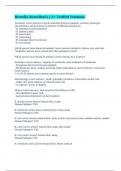Brucella (brucellosis) || A+ Verified Solutions.
Taxonomy correct answers 6 species identified based on antigenic variation, phenotypic
characteristics, and prevalence of infection in different animal hosts
- B. melitensis (small ruminants)
- B. abortus (cattle)
- B. suis (swine)
- B. canis (dogs)
- B. neotomae (desert wood rats)
- B. ovis (sheep)
Which species cause disease in humans? correct answers melitensis, abortus, suis, and canis
*melitensis and suis more virulent than other pathogenic forms*
Which species cause disease in animals? correct answers ALL 6 species
Prevalence correct answers - majority of worldwide cases attributed to B melitensis
- B inopinata discovered in breast implants
- Mediterranean basin, Arabian peninsula, Indian subcontinent, parts of Mexico, Central and
South America
*- in US, B. abortus most common species to cause disease*
Microbiology correct answers - small, nonmotile, facultative, intracellular aerobic rods
- single, tiny, gram negative coccobacilli (stain red)
- no capsules, spores, or flagella
History correct answers - Discovered by David Bruce in 1887
- first identified in goats' milk
- pasteurization eliminated it in dairy products
B. abortus correct answers Natural Host: Cattle
Human Pathogen? YES
B. melitensis correct answers Natural Host: Goats, sheep
Human Pathogen?: YES
B. suis correct answers Natural Host: swine (classic association), hares, reindeer/caribou, rodents
Human Pathogen?: YES
B. canis correct answers Natural Host: dogs, other canids
Human Pathogen?: YES
B. ovis correct answers Natural Host: sheep
Human Pathogen?: NO
B. neotomae correct answers Natural Host: desert wood rat
, Human Pathogen?: NO
Brucella transmission correct answers *- consumption, direct contact, inhalation of aerosol*
- occupational disease: shepherds, abattoir workers, veterinarians, dairy-industry professionals,
personnel in microbiology labs
- multiplies in uterus, attracted to tissues rich in erythritol (animal uterus, breast, placenta)
- consumption of unpasteurized dairy products (most common - raw milk, soft cheese, butter, ice
cream)
- undercooked liver/spleen (Reticuloendothelial system - lymph nodes, bone marrow, immune
system tissues)
B abortus and B melitensis classic transmission correct answers Milk, slaughter, veterinary care
B suis classic transmission correct answers Slaughter, veterinary care
B canis classic transmission correct answers Veterinary care
Brucellosis Incubation Period correct answers 5-60 days, but 1-2 months common
Brucellosis Epidemiology correct answers - B melitensis most common type seen with disease
and most prevalent
- B abortus most widespread cause of infection but rarely causes human disease
- in US, most commonly see B abortus (CA, TX, FL, VA), but still v rare (0.5 cases/100,000
people)
- association with exposure to farm animals
Species Severity in Humans correct answers B melitensis > B suis > B abortus > B canis
Person to Person Transmission to Humans correct answers *extremely rare*
close personal contact and tissue transplantation
Environment Transmission to Humans correct answers - contaminated by birth
products/abortions of infected animals
- can be spread by inhalation of contaminated dust
- can survive for long periods of time in dust, dug, slurry, water, soil, carcasses
Occupational Exposure Transmission to Humans correct answers handling and processing of
animal products, laboratory workers
Foodborne Transmission to Humans correct answers *MOST COMMON CAUSE*
- ingestion of fresh milk and dairy products
- soft cheeses are especially dangerous given that the process can actually concentrate the
organism
- meat products less associate with disease b/c not eaten raw
- muscle tissues don't concentrate pathogen as well as other tissues




